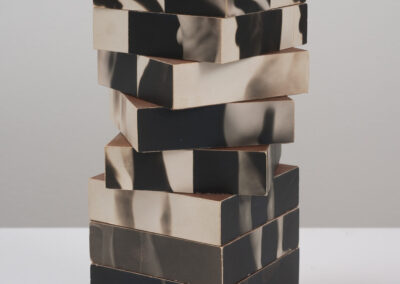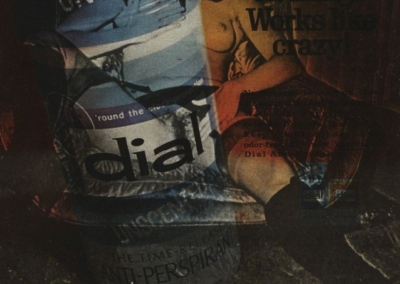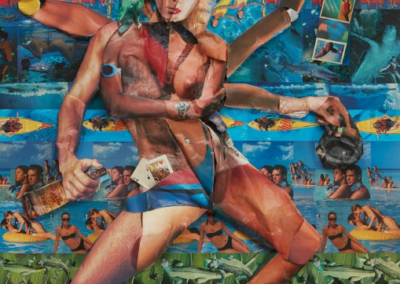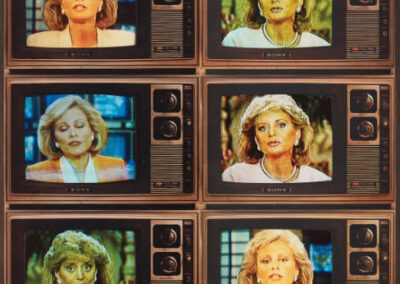Our next Artist You Need To Know is Robert Heinecken (1931 – 2006). He spoke of himself as a “paraphotographer” – because his photographic process and artworks were often made without a camera.
Heinecken’s obituary in the New York Times offers the following: “Instead of treating photographs as the autonomous creations of their makers, as did Ansel Adams and other postwar tastemakers, he viewed them as forms of cultural iconography that reflected the commercialism and venality of contemporary life.” He challenged the ‘boundaries of the photographic medium, breaking through aesthetic and technical limitations of the genre.” (from here)
Heinecken himself succinctly described his aesthetic in the following manner: “There is a vast difference between taking a picture and making a photograph.”
The son of a Lutheran minister, Heneicken joined the US Army in 1954 where he was a fighter pilot (he passed a height test by padding his socks with paper. One can be forgiven for seeing a parallel between this unorthodox approach here and his later aesthetic decisions). He was discharged from the Marines in 1957.
Heinecken attended the University of California at Los Angeles (where he studied printmaking as well as photographery) as an undergraduate, but also earned his master’s degree there in 1960. Quickly hired as a professor at the same institution to teach photography, Heneicken would be a mainstay of that department for the next three decades. He founded the photography department at UCLA (1963) and helped found the Society for Photographic Education in 1964 (an organization of college-level teachers), serving as chairman in 1970 and 1971. Heinecken also taught at the School of the Art Institute of Chicago (his second wife, the equally significant photographer Joyce Neimanas, was also on faculty there). Before moving to New Mexico in 2004, they often divided their time between Chicago and Los Angeles.
Heinecken’s significance is not just for his groundbreaking irreverence for photography, but also as an educator: many of his students helped further shape the conversation about photography in Los Angeles and beyond. These include: John Divola, Eileen Cowin, Graham Howe, Jo Ann Callis and Ray McSavaney.
“Over five decades, Robert Heinecken’s work as an artist and teacher radically expanded the reach of photography. A precursor to appropriation artists of the 1980s, Heinecken is known for series like the influential Are You Rea (1966-67), in which he used magazine pages placed on light tables to create unexpected juxtapositions of advertising and feature photography. [With] unconventional processes and irreverent attitude, Heinecken typically worked from found images, transforming them through methods like lithography, etching, and direct-exposure photograms.” (From here)
In his practice, Heinecken was known for “appropriating and re-processing images from magazines, product packaging or television. In his Are You Rea series (1964 to 1968) he created a portfolio of images filled with unexpected and sometimes surreal juxtapositions by placing a single magazine page on a light table, so that the resulting contact print picks up imagery from both sides of the page.” Later in that same decade, Heinecken began removing pages and parts from magazines such as “Time and Vogue and inserting sexual or pornographic images into them. He would place his collage-publications back on newsstands in Los Angeles to be sold to unsuspecting buyers.”
But from the early 1970s and onward Heinecken “started to expose food directly on light sensitive materials. He realized these “documentary photograms” first on black and white paper and later in colour in the series Various Lunches on positive Ilfochrome paper. In 1983 / 84 he created such Foodograms even on large polaroid sheets (20 x 24 inches) in collaboration with John Reuter…[and beginning in the] 1980s, he focused on a body of work he described as ‘videograms’, which included several series on American news television that involved photographing images on the television or exposing the light of a television set directly to paper…” (from here).
Important exhibitions of Heinecken’s work have been mounted at the Museum of Contemporary Photography, Chicago and a 35-year retrospective at the Museum of Contemporary Art, Chicago (1999) that toured to the Los Angeles Country Museum of Art that same year. An encompassing retrospective Object Matter was on display at the Museum of Modern Art in New York in 2014, which travelled to The Hammer Museum of Art, Los Angeles CA. His work has also been shown at Gallery Min (Tokyo, Japan), the Armory Centre for the Arts, the Museum of Contemporary Photography at Columbia College (Chicago, IL) and in Arles (France). Many of these happened posthumously: but during his lifetime, Heinecken often exhibited in ‘traditional’ photography galleries. Since his passing, the MOMA has exhibited and situated his work with the Pictures Generations artists (Cindy Sherman, John Baldessari, Richard Prince) in a more conceptual framework.
Heinecken’s art can be found in the collections of the following institutions: Art Institute of Chicago (Chicago, IL); The Art Museum, Princeton University (Princeton, NJ); Baltimore Museum of Art (Baltimore, MD); Center for Creative Photography, University of New Mexico (Tucson, AZ); George Eastman House (Rochester, NY); Los Angeles County Museum of Art (Los Angeles, CA); Maison Européenne de la Photographie (Paris, France); Museum of Contemporary Art (Chicago, IL); Museum of Cotemporary Art (Los Angeles, CA); Museum of Contemporary Photography (Chicago, IL); Museum of Fine Arts (Houston, TX); Museum of Modern Art (Kyoto, Japan); Museum of Photographic Arts (San Diego, CA); National Gallery of Canada (Ottawa, ON); Polaroid Collection (Cambridge, MA); San Francisco Museum of Modern Art (San Francisco, CA); Seattle Art Museum (Seattle, WA); Sheldon Memorial Art Gallery (University of Nebraska, Lincoln, NE); Spencer Museum of Art (University of Kansas, Lawrence, KS); Tokyo Metropolitan Museum of Photography (Tokyo, Japan); University of New Mexico (Albuquerque, NM): and the Whitney Museum of American Art, New York, NY
He also produced two publications: Retro / Verso (2006) and Heinecken (1980, a limited edition of 2000 copies). A more in depth listing of Heinecken’s exhibitions and accomplishments can be seen here.
In response to a retrospective exploring and recognizing Heinecken’s importance to the history of photography – the aforementioned Object Matter – a reviewer offered the following: “Object Matter demonstrates that Heinecken was completely dedicated to expanding the field of photography. Though his creations are often hard to stomach, his methodology becomes clearer as one progresses through the exhibition. The show’s title refers to a 1965 quote by the artist. “The photograph … is not a picture of something but an object about something.” Heinecken was committed to exposing the ideologies that lurk behind the creation and manipulation of images. His art encourages us to be active viewers. For some, these works raise a difficult question. Did their creation stem from a need to fetishize the nude form, or to fetishize the medium of photography? As is true of most artists, the answer probably involves both.” (from here)
Another critic observed this, in speaking of the relevance of Heinecken’s work to us, today: “The media is increasingly our nature, our ecosystem, and we need Heineken’s art more than ever.” (from here)
Much more of Robert Heinecken’s work – as he was very prolific – can be enjoyed here, at the University of Arizona’s Centre for Creative Photography site.



























